► Out later this year, and based on the Casper
► Inster baby EV priced from £23,495 in the UK
► Roomy, innovative interior
Hyundai has confirmed pricing for its all-electric Inster supermini. The brand says the baby EV’s pricing starts at £23,495 in the UK.
The Inster is a (mostly) new A-segment EV designed to sit at the bottom of the brand’s electric offering, under the Ioniq 5 SUV and Ioniq 6 streamliner. It uses the South Korea-only, combustion-powered Casper as a base, but stretches the wheelbase before filling it with an EV powertrain and some pretty innovative features.

What does Inster mean?
Hyundai is calling its new A-segment EV the Inster, which isn’t short for Instagram, but is instead a mish-mash of the words ‘intimate’ and ‘innovative.’ Nope, we don’t get the link either. It seems the suits in HQ knew the ‘Casper’ name used by the combustion version would not go down well, but chose a slightly more embarrassing moniker to replace it.
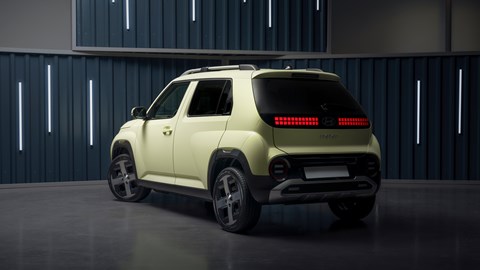
Why not call it an Ioniq model? That’s easy, because it according to Hyundai suits that sub-brand is reserved for EVs that use Hyundai’s E-GMP platform.
As a result of Hyundai’s tinkering, the Casper’s transformation to an EV has added an extra 230mm of length with 180mm of that in the wheelbase. Almost all the length is to the benefit of the rear passengers.
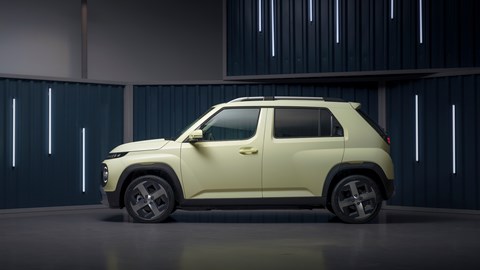
What are the specs?
The Inster will be available in a 42kWh version capable of up to 203 miles, and a Long-Range 49kWh version capable of 229 miles. Both models will use a single motor for 95bhp in the 42kWh model and 113bhp in the Long-Range 49kWh car. Torque is the same for both at 108lb ft.
When using a 120 kW DC charger it’ll recharge from 10 to 80 percent in around 30 minutes and the Inster can even can be ordered with vehicle-to-load technology.
It looks unusual!
‘The design is all about having a charismatic exterior and a very functional interior, Victor Andrean, Hyundai designer told CAR. ‘Important is this very high nose and the general proportions. It makes you feel like you can take it on an adventure and feels a bit off-roady in a way. It’s got this duality between friendliness and ruggedness.’
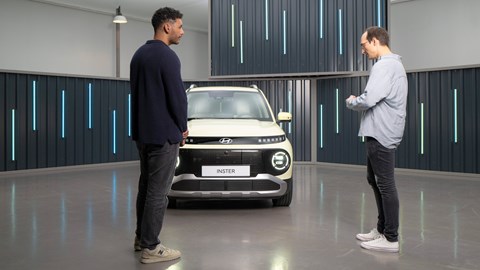
In order to acknowledge its new EV powertrain, Hyundai’s stylists kept the broad strokes of the Casper, but gave it the usual smattering of pixels as its other EVs. ‘When you see pixels, it’s Hyundai. It’s EV,’ Andrean tells us.
It’ll run on 15-inch steel rims with wheel covers, 15-inch alloys or 17-inch alloy wheels for the higher spec cars.
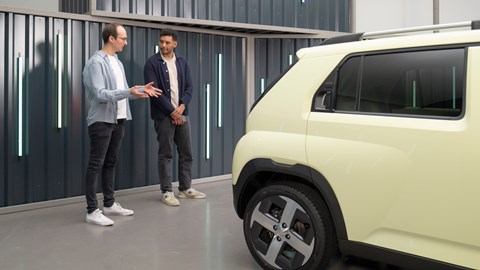
What about inside?
Despite all the style, the Inster looks a little ungainly on the outside – but it all pays off once you get in the cabin. It’s decked out in sustainable materials but almost everywhere you look, Hyundai’s engineers have crammed innovative, practical thinking. The dashboard is symmetrical, even the front row of seats feels airy, and a lack of transmission tunnel means that the driver can easily exit the car from the passenger door. ‘You could say it’s democratic,’ Andrean tells us as we shuffle out for the third time.

Above you’ll find a sunroof, and elsewhere a wireless charger and 64-colour ambient lighting. All the usual tech is here too, such as ADAS and lane-keeping along with a duo of 10.25-inch screens. There’s a good amount of open storage for quickly stowing bits and pieces.

However, it’s at the rear where the extra 230mm in length over the Casper really pays off. Adjustable and reclinable seats make it easy to get comfy and on the most extreme inclined setting I had more than enough room to relax behind myself. Pretty impressive for an A-segment EV.
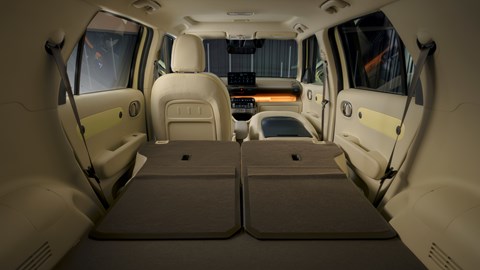
There are other nice touches: the front passenger seat can fold down so the driver can put their bags next to them, and it’ll also act as a footrest for rear passengers with delusions of grandeur.
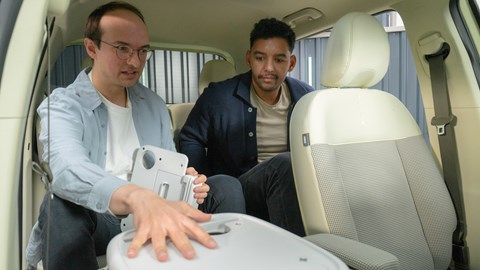
The rear door cards and front seats also feature attachments which Hyundai says will be used for a range of accessories. We’ve seen a few prototypes in action; from a table to a wallet and photo album. Cool, but not essential.
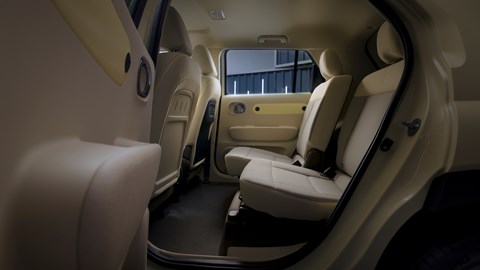
Anything else?
CAR understands that a more rugged version called the Inster Cross will follow in a few months. Although it’ll look different, it’ll have the same ride height and dimensions – just expect more adventurous-looking front and rear bumpers. The interior could have a different spin too.
Hyundai suits hinted that there’ll also be a cheeky N-line version of the Inster to come – and we’re here for it.
How much?!
Hyundai says the Inster range will start from £23,495 for the 42kWh battery option and can be had with the larger battery or more powerful battery. The base Inster ’01’ model features 15-inch alloys, a 10.25-inch infotainment screen, digital instrument cluster, rear parking sensors and camera, adaptive cruise, climate control and more besides.
The Inster ’02’, priced from £26,495, is only available with the larger 49kWh battery and 113bhp motor, and comes with bigger wheels, front parking aids, those clever folding/sliding seats and heated front seats.